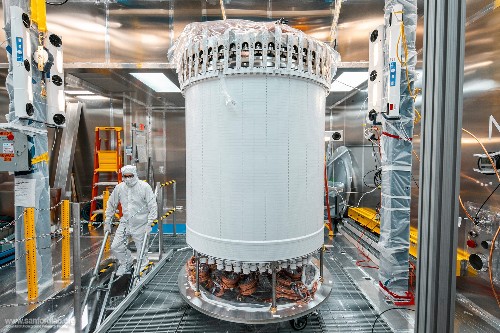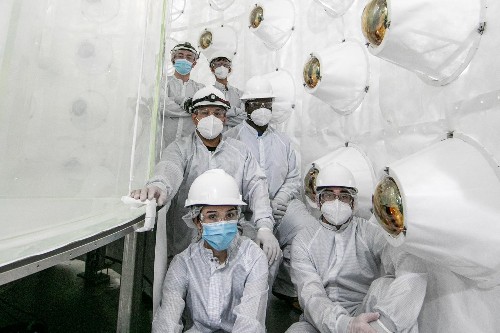
LZ's central detector, the time projection chamber, in a surface lab clean room before delivery underground.Matthew Kapust/Sanford Underground Research Facility

Researchers sit between two outer layers of LZ during construction. The clear inner tank was later filled with special liquid scintillator; photomultipliers on the outer wall collect light from background particle interactions.Matthew Kapust/Sanford Underground Research Facility
New results from the world's most sensitive dark matter detector narrow down its characteristics, edging closer to unravelling one of the biggest mysteries of the Universe.
The LUX-ZEPLIN Dark Matter Experiment (LZ), based at the Sanford Underground Research Facility in South Dakota, US, has analysed extensive data which gives unprecedented insights into one of the leading candidates for dark matter known as weakly interacting massive particles, also called WIMPs.
The findings, presented on Monday at the TeV Particle Astrophysics 2024 Conference in Chicago, Illinois, and the LIDINE 2024 Conference in São Paulo, Brazil, are nearly five times more sensitive than previous investigations and indicate WIMPs seldom interact with ordinary matter, confirming just how difficult dark matter is to trace.
The LZ project is led by the US Department of Energy's (DOE) Lawrence Berkeley National Laboratory (Berkeley Lab). Physicists from the University of Bristol are part of the international endeavour, involving more than 250 researchers from the US, UK, Australia, Portugal, South Korea and Switzerland. It is the world's largest and most sensitive experiment searching for dark matter particles, in particular WIMPs.
Collaborator Henning Flaecher, Professor of Physics and Principal Investigator of the Bristol group, said: "The results present a significant improvement over previous searches for WIMP dark matter. We have probed a large range of masses that dark matter could have and its interaction strength with normal matter but so far it remains elusive. Searching for dark matter is definitely a marathon and not a sprint, and with LZ still to collect roughly three times more data than was used for these latest results, everything is still to play for."
LZ found no evidence of WIMPs above a mass of 9 GeV/c2, where 1 GeV/c2 roughly corresponds to the mass of a hydrogen atom.
The experiment now needs to run for up to 1,000 days to realise its full sensitivity. This initial result is just a fraction of that exposure, which validates the decade-long design and construction effort.
LZ, supported in the UK by UKRI's Science and Technology Facilities Council, is intricately and innovatively designed to find direct evidence of dark matter – a mysterious invisible substance thought to make up most of the mass of the Universe. Dark matter is particularly challenging to detect, as it does not emit or absorb light or any other form of radiation.
The LZ detector tries to capture the very rare and very faint interactions between dark matter and its 7-tonne liquid xenon target. To do this, LZ must be carefully and delicately calibrated and any background noise removed so the experiment can be perfectly tuned to observe these interactions.
These theorised elementary particles interact with gravity, which confirms the existence of dark matter in the first place, and possibly through a new weak interaction too.
This means WIMPs are expected to collide with ordinary matter – albeit very rarely and very faintly. This is why very quiet and very sensitive particle detectors are needed for WIMP detection.
At the centre of the experiment is a large liquid xenon particle detector maintained at around -110oC, surrounded by photo-sensors. If a WIMP interacts with a xenon atom, a tiny amount of light should be emitted and the sensors will capture it. But in order to see these rare interactions, the team had to carefully remove as much as possible background radiation from the detector materials first.
But this is not enough and explains why LZ is operating around a mile underground. This shields it from cosmic rays, which bombard experiments at the surface of the earth. The detector and its cryostat sit inside a huge water tank to protect the experiment from particles and radiation coming from the laboratory walls.
Researchers from the University of Bristol play important roles in the experiment, with Christopher Wright and Nathan Pannifer working 1500m underground in South Dakota as part of their PhD, contributing to the running and maintenance of the Outer Detector (OD). This component of LZ is used to suppress signals stemming from neutrons and gamma rays, backgrounds that can mimic dark matter interactions. Based on data collected with the OD, Sam Eriksen, a Senior Research Associate, led the development of the neutron veto and the measurement of its efficiency for the current analysis.
Prof. Flaecher added: "For dark matter searches it is of vital importance to suppress any sources of background radiation, in particular neutrons and gamma rays. LZs veto detectors enable us to reject such processes and to gain the sensitivity to extremely rare dark matter interactions.
"Finally, LZ made sure that the liquid xenon itself is as pure as possible by carefully removing a key contaminant through a complex years-long process. Many complex systems had to come together for LZ to work, and these results show they are performing in seamless harmony."






